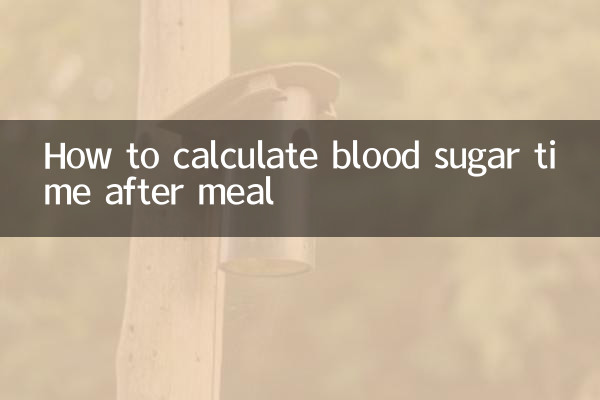How to calculate blood sugar time after meal
In recent years, with the improvement of health awareness, blood sugar management has become a hot topic of public concern. In particular, the monitoring and calculation of postprandial blood sugar is directly related to the daily health management of diabetic patients. This article will combine the popular discussions on the Internet in the past 10 days to provide you with a detailed analysis of the time calculation method for postprandial blood sugar and provide a structured data reference.
1. What is postprandial blood sugar?

Postprandial blood glucose refers to the concentration of glucose in the blood after eating. Usually, the postprandial blood sugar of healthy people will reach a peak within 1-2 hours after eating, and then gradually fall back. For patients with diabetes, postprandial blood sugar control is particularly important because long-term high blood sugar may cause a variety of complications.
2. Calculation method of postprandial blood sugar time
Postprandial blood glucose is usually calculated from the first bite of food. The following are blood glucose monitoring standards at different time points:
| time point | Blood sugar range (healthy people) | Blood sugar range (diabetics) |
|---|---|---|
| 1 hour after meal | 6.7-8.9 mmol/L | ≤10.0 mmol/L |
| 2 hours after meal | ≤7.8 mmol/L | ≤7.8 mmol/L (ideal value) |
| 3 hours after meal | close to fasting level | ≤5.6 mmol/L (recommended value) |
3. Factors affecting postprandial blood sugar
Fluctuations in blood sugar after meals are affected by many factors, including:
| Influencing factors | Description |
|---|---|
| food type | High GI (glycemic index) foods can quickly raise blood sugar |
| eating speed | The faster you eat, the more obvious your blood sugar rises |
| amount of exercise | Proper exercise after meals can help lower blood sugar |
| Insulin function | Diabetic patients do not secrete enough insulin, making it more difficult to control blood sugar |
4. How to scientifically monitor postprandial blood sugar?
1.Timing measurement:Start timing from the first bite of food, and measure blood sugar levels 1 hour, 2 hours, and 3 hours later.
2.Record data:It is recommended to use a blood glucose meter and record each measurement so that trends can be analyzed.
3.Adjust your diet:Optimize the diet structure based on blood sugar data and reduce the intake of high-sugar and high-fat foods.
5. Popular discussion on the Internet: Misunderstandings about postprandial blood sugar
Recently, misunderstandings about postprandial blood sugar have become a hot topic. The following are common questions from netizens:
| Misunderstanding | scientific explanation |
|---|---|
| "The lower the blood sugar after a meal, the better" | Too little blood sugar can lead to hypoglycemia, which is equally dangerous |
| “Only measuring fasting blood sugar is enough” | Postprandial blood sugar better reflects daily blood sugar fluctuations |
| “You can control sugar by not eating staple food” | Not eating staple food at all may lead to energy deficiency, so you should choose low GI staple food |
6. Summary
The calculation and management of postprandial blood sugar is an important part of blood sugar control. Through scientific monitoring, reasonable diet and appropriate exercise, blood sugar stability can be effectively maintained. If you are a diabetic, it is recommended to consult your doctor regularly to develop a personalized blood sugar management plan.
I hope this article can help you better understand the time calculation method for post-meal blood sugar and protect your healthy life!

check the details

check the details